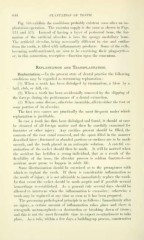Page 650 - My FlipBook
P. 650
648 PLANTATION OF TEETH. —
Fig. 57G exhibits the conditions probably existent soon after an im-
plantation operation. The vascular supply is the same as shown in Figs.
574 and 575. Instead of having a layer of periosteal bone, the for-
mation of the artificial alveolus is into the spongy medullary bone.
The artificial alveolus, being necessarily dilferent in size and outline
from the tooth, is tilled with inflammatory producfts. Some of the cells,
becoming multi-nucleated, are seen to be exercising their phagocytic
or, in this connection, resorptive—function u])(»n the cemeutum.
Replantation and Transplantation.
Replantation.—In the present state of (huital practice the following
conditions may be regarded as warranting replantation :
(1) When a tooth has been dislodged by traumatism, a blow by a
ball, club, or fall, etc.
(2) When a tooth has been accidentally removed by the slipping of
the forceps during the performance of a dental extraction,
(3) When some disease, otherwise incurable, aifects either the root or
some portion of its alveolus.
The first two causes are practically the most frequent under which
replantation is justifiable.
In case a tooth has thus been dislodged and found, it should at once
be cleansed of all foreign matter and then be carefully examined for
fractures or other injury. Any cavities present should be filled, the
contents of the root canal removed, and the space filled in the manner
described later ; fractured or abraded portions or surfaces are to be made
smooth, and the tooth placed in an antiseptic solution. A careful ex-
amination of the socket should then be made. It will be noticed when
the accident has befallen a young individual, that as a result of the
flexibility of the bone, the alveolar process is seldom fractured—an
accident more prone to hajipen in adult life.
Some discrimination should be exercised as to the promptness with
which to replant the tooth. If there is considerable inflammation as
the result of injury, it is not advisable to immediately re})lace the tooth.
In that event the socket should be made aseptic and if possible normal
hemorrhage re-established. As a general rule several days should be
allowed to intervene when the inflammation is excessive ; otherwise a
tooth may be replaced at any time as soon as it has been prepared.
The governing pathological ]H"inciple is as follows : Immediately after
an injury, a certain amount of inflammation takes place and there is
retrograde metamorphosis—a destruction or breaking down of tissue ;
and this is not the most favorable time to expect re-attachment to take
place. As a rule, wdthin a few days a building-up process, constructive


